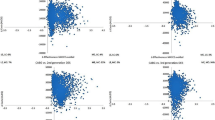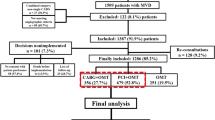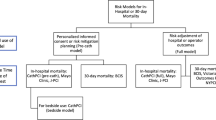Abstract
Objectives
During recent years, numerous clinical and procedural risk factors for adverse outcomes after percutaneous coronary interventions (PCI) have been identified. Due to the high economic pressure in many national health care systems, it is of some interest whether these predictors of clinical risks represent also the main cost drivers.
Methods
Data of 770 patients undergoing PCI were retrospectively analyzed. Risk factors for PCI as well as angiographic classifications were adopted from the ACC/AHA Guidelines. In-hospital costs for each patient were obtained from thoroughly performed calculations for the national Diagnosis Related Groups database in Germany.
Results
Creatinine >2 mg/dl (192% of average costs, P < 0.0001), EF ≤ 35% (146%, P < 0.0001), presence of a thrombus (146%, P < 0.0001), PCI of a venous bypass (143%, P < 0.0001), CCS class IV (123%, P < 0.0001), coronary three-vessel disease (119%, P < 0.0001) and age (112%, P = 0.014) were associated with both higher in-hospital mortality and costs. Furthermore, in patients with acute coronary syndromes the time delay from onset of symptoms until PCI had marked impact on costs.
Conclusions
Most predictors for adverse outcome after PCI were also found to be major cost drivers. Moreover, time delay from onset of ACS to PCI had marked impact on costs and should be implemented in the reimbursement systems.




Similar content being viewed by others
Abbreviations
- CABG:
-
Coronary artery bypass grafting
- DRG:
-
Diagnosis related group
- EF:
-
Ejection fraction (left ventricular)
- MI:
-
Myocardial infarction
- PCI:
-
Percutaneous coronary intervention
- CCS:
-
Canadian cardiovascular society
- BMI:
-
Body mass index
- ACS:
-
Acute coronary syndrome
- LV:
-
Left ventricular
References
Best PJ, Lennon R, Ting HH, Bell MR, Rihal CS, Holmes DR, Berger PB (2002) The impact of renal insufficiency on clinical outcomes in patients undergoing percutaneous coronary interventions. J Am Coll Cardiol 39:1113–1119
Blackman DJ, Pinto R, Ross JR, Seidelin PH, Ing D, Jackevicius C, Mackie K, Chan C, Dzavik V (2006) Impact of renal insufficiency on outcome after contemporary percutaneous coronary intervention. Am Heart J 151:146–152
Block PC, Peterson ED, Krone R, Kesler K, Hannan E, O’Connor GT, Detre K (1998) Identification of variables needed to risk adjust outcome of coronary interventions: evidence-based guidelines for efficient data collection. J Am Coll Cardiol 32:275–282
Cockroft DW, Gault MH (1976) Prediction of creatinine clearance from serum creatinine. Nephron 16:31–41
Cohen DJ, Becker ER, Culler SD, Ellis S, Green LM, Schnitzler RN, Simon AW, Weintraub WS (2000) Impact of patient characteristics, complications, and facility volume on the costs and time of cardiac catheterization and Coronary Angioplasty in 70 catheterization laboratories. Am J Cardiol 86:595–601
Cohen HA, Williams DO, Holmes DR Jr, Selzer F, Kip KE, Johnston JM, Holubkov R, Kelsey SF, Detre KM (2003) Impact of age on procedural and 1-year outcome in percutaneous transluminal coronary angioplasty; a report from the NHBLI dynamic registry. Am Heart J 146:513–519
Cook S, Walker A, Hügli O, Togni M, Meier B (2007) Percutaneous coronary interventions in Europe. Clin Res Cardiol 96:375–382
Hlatky MA, Boothroyd DB, Brooks MM, Winston C, Rosen A, Rogers WJ, Reeder GS, Smith HC, Ryan TJ, Pitt B, Whitlow PL, Wiens RD, Mark DB (1999) Clinical correlates of the initial and long-term cost of coronary bypass surgery and coronary angioplasty. Am Heart J 138:376–383
Kidney Disease Outcome Quality Initiative (K/DOQI) Advisory Board: K/DOQI clinical practice guidelines for chronic kidney disease: evaluation, classification, stratification. Kidney Disease Outcome Quality Initiative (2002) Part 4: Definition and classification of stages of chronic kidney disease. Am J Kidney Dis 39:S46–S64
Kozak LJ, Lees KA, DeFrances CJ (2006) National hospital discharge survey: 2003 annual summary with detailed diagnosis and procedure data. National center for health statistics. Vital Health Stat 160(13):1–206
Mehta L, Devlin W, McCullough PA, O’Neill WW, Skelding KA, Stone GW, Boura JA, Grines CL (2007) Impact of body mass index on outcomes after percutaneous coronary intervention in patients with acute myocardial infarction. Am J Cardiol 99:906–910
Minutello RM, Chou ET, Hong MK, Bergman G, Parikh M, Iacovone F, Wong SC (2004) Impact of body mass index on in-hospital outcomes following percutaneous coronary intervention (Report from the New York State Angioplasty Registry). Am J Cardiol 93:1229–1232
Murray CJ, Lopez AD, Jamison DT (1994) The global burden of disease in 1990: summary results, sensitivity analysis and future directions. Bull World Health Organ 72:495–509
Reinecke H, Trey T, Matzkies F, Fobker M, Breithardt G, Schaefer RM (2003) Grade of chronic renal failure, and acute and long-term outcome after percutaneous coronary interventions. Kidney Int 63:696–701
Schuler J, Maier B, Behrens S, Thimme W (2006) Present treatment of acute myocardial infarction in patients over 75 years. Clin Res Cardiol 95:360–367
Smith SC Jr, Dove JT, Jacobs AK, Kennedy JW, Kereiakes D, Kern MJ, Kuntz RE, Popma JJ, Schaff HV, Williams DO, Gibbons RJ, Alpert JP, Eagle KA, Faxon DP, Fuster V, Gardner TJ, Gregoratos G, Russell RO, Smith SC Jr (2001) ACC/AHA guidelines for percutaneous coronary intervention: a report of the American College of Cardiology/American Heart Association Task Force on Practice Guidelines (Committee to Revise the 1993 Guidelines for Percutaneous Transluminal Coronary Angioplasty). J Am Coll Cardiol 37:2239i–2239lxvi
Smith SC, Feldman TE, Hirshfeld JW, Jacobs AK, Kern MJ, King SB III, Morrison DA, O’Neill WW, Schaff HV, Whitlow PL, Williams DO (2006) ACC/AHA/SCAI 2005 guidelines update for percutaneous coronary intervention: a report of the American College of Cardiology/American Heart Association Task Force on Practice Guidelines (ACC/AHA/SCAI Writing Committee to Update the 2001 Guidelines for Percutaneous Coronary Intervention). Circulation 113:e166–e286
van Buuren F, Horstkotte D (2006) 21st Report of performance data from heart catheterization laboratories in Germany. 2004 results of a collaborative survey by the Committee of Clinical Cardiology and the Interventional Cardiology and Angiology Study Groups of the German Society of Cardiology, Cardiovascular Research. Clin Res Cardiol 95:383–387
Wienbergen H, Gitt AK, Juenger C, Schiele R, Heer T, Towae F, Gohlke H, Senges J (2007) Impact of the body mass index on occurrence and outcome of acute ST-elevation myocardial infarction. Clin Res Cardiol Epub
Acknowledgments
The authors are indebted to Mr. Ing. (grad.) Klaus Balkenhoff for establishing the PCI database. We thank all technicians and nurses in the catheterization laboratories of the Department of Cardiology and Angiology of the Hospital of the University of Münster, Münster, Germany, for their ongoing support.
Author information
Authors and Affiliations
Corresponding author
Rights and permissions
About this article
Cite this article
Pohlen, M., Bunzemeier, H., Husemann, W. et al. Risk predictors for adverse outcomes after percutaneous coronary interventions and their related costs. Clin Res Cardiol 97, 441–448 (2008). https://doi.org/10.1007/s00392-008-0647-8
Received:
Accepted:
Published:
Issue Date:
DOI: https://doi.org/10.1007/s00392-008-0647-8




